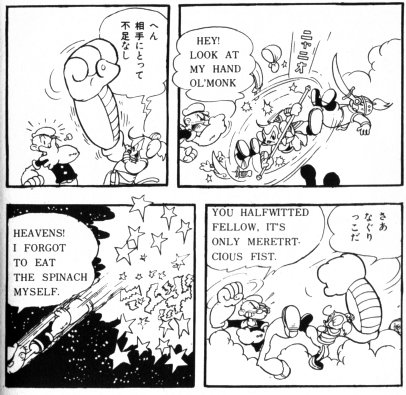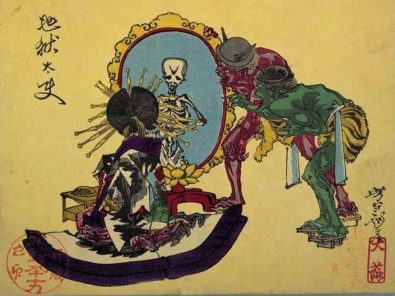So I was reading Czeslaw Milosz's Selected Poems ("Revised") and I came across one which mentioned Japan. In translation (credited to "A.M.", which apparently stands for Anthony Milosz), it goes like this:
NO MORE
I should relate sometime how I changed
My views on poetry, and how it came to be
That I consider myself today one of the many
Merchants and artisans of Old Japan,
Who arranged verses about cherry blossoms,
Chrysanthemums and the full moon.
If only I could describe the courtesans of Venice
As in a loggia they teased a peacock with a twig,
And out of brocade, the pearls of their belt,
Set free heavy breasts and the reddish weal
Where the buttoned dress marked the belly,
As vividly as seen by the skipper of galleons
Who landed that morning with a cargo of gold;
And if I could find for their miserable bones
In a graveyard whose gates are licked by greasy water
A word more enduring than their last-used comb
That in the rot under tombstones, alone, awaits the light,
Then I wouldn't doubt. Out of reluctant matter
What can be gathered? Nothing, beauty at best.
And so, cherry blossoms must suffice for us
And chrysanthemums and the full moon.
Google Books reveals that Milosz himself discussed this poem in a lecture entitled "A Quarrel with Classicism," collected in The Witness of Poetry. In this lecture, Milosz frames the poem as an exploration of the tension between "classicist and realistic tendencies residing in one person and struggling with each other." This contradiction, argues Milosz, "was not clearly perceived" by Renaissance poets but "resides at the very foundation of the poet's endeavor" today.
It seems to me that the poem is quite perverse. We are used to viewing Chinese and Japanese poetry as examples of a peculiar attachment to conventions. Thus the persona speaking here renounces his ambitious pursuit of reality and chooses instead cherry blossoms, chrysanthemums, and the full moon; those are permanent accessories of the kind of poetry that is not unlike a societal game, for it is universally practiced and assessed according to one's skill in the use of those accessories. "Merchants and artisans of Old Japan," average people who practiced poetry in their free moments, are introduced in order to stress the integral place of the versifier's craft in the habits of all society. We have here a radical renouncement of the heritage of bohemia, with its pride in the isolated and alienated poet. And yet the speaker affirms that his choice is an act of resignation, made because the achievement of certain goals was for him impossible. "If only I could," he says. Could what? Describe. Then follows a description of Venetian courtesans, which paradoxically shows us the poet achieving what, in his opinion, was beyond his power. [...]
The description of the courtesans in my poem is placed between "If only I could describe" and "Then I wouldn't doubt." And the doubt comes from the fact that matter resists amorous possession by the word, and what can be gathered out of it is "beauty at best." If I understand the persona, with whom I am identical to a certain extent, he does not have in mind the beauty contained in Nature, in views of sky, mountains, sea, sunsets, but the beauty of form in a poem or painting. He proclaims that this does not satisfy him, since it can be obtained only at the price of renouncing the truth, which would be tantamount to a perfect mimesis. Cherry blossoms, chrysanthemums, and the full moon are ready-made pieces serving a merchant or artisan of Old Japan to arrange beautiful forms again and again. The statement affirming that this should suffice acquires a shade of irony and in fact a declaration of disagreement with classicism.
Meanwhile, Emily Grosholz in "Milosz and the Moral Authority of Poetry" (an essay in the James McCorkle-edited Conversant essays: contemporary poets on poetry) takes a slightly different view:
What I find so attractive about the poem is the richness of nuance in the poet's depiction of the courtesans and of his relation to them. [...] Like Carpaccio, to whose painting the poem makes reference, Milosz balances the demands of aesthetic paganism and Catholic asceticism; he mourns and celebrates these women who, like him, endure their mortality even as they (paradoxically) await the light. The tense, erotic sympathy which exists between artist and human subject applies as well to Carpaccio and his original models and, no doubt, to the artisans of Old Japan who commented on human affairs when they used the convention of flower and moon.
Years of nerd training took over to provide my first instinctive reaction to all of this: indignant scorn over a relatively insignificant technical issue. Chrysanthemums aren't that prominent as a theme in Japanese poetry! You're just saying that because of Pierre Loti! There isn't a single one in the Man'yōshū! ... But, actually, it turns out that chrysanthemums weren't even introduced to Japan until the Nara period, which makes them roughly contemporaneous with the MYS (and also explains the Chinese-only name, now that I think of it; duh), and chrysanthemums do appear in later poetry collections: eleven times in the Kokin wakashū (10th century), twelve times in the Shin kokin wakashū (15th century) — that's only about half as frequent as in the Kokin wakashū, given the difference in size, but it's once more often than wisteria, for example — and by the Edo period Japan had cheerfully adopted the Chinese concept of the "four gentlemen" (四君子) of botanical aesthetics: plum, chrysanthemum, orchid, bamboo. So I suppose my first reaction is just straight-up Naracentricism. I need to unpack my invisible eboshi, for sure.
My second comment is similarly point-missing: it wasn't really "merchants and artisans" of "Old Japan" who wrote poetry like this. By the time you had merchants and artisans notably active in poetry, simply arranging flowers and moons was no longer enough. I am thinking in particular of the Edo period and the rise of haiku. Ironically, what you had here was an attempt to take the Japanese poem beyond artisan-like classicism and towards a more bohemian, realistic approach, to use Milosz's terms.
There is one big difference, though: Milosz's poem's narrator seems to believe that if he can't capture everything in a poem, then he shouldn't bother capturing anything at all. Haiku avoid this problem by capturing just one thing, leaving the galleon skippers and miserable bones for the reader to fill in (or not, as they please). Perhaps Milosz's poem can also be read as a "perfect is the enemy of the good" allegory.
![[No-sword]](http://no-sword.jp/images/site/no-sword_banner.jpg)




